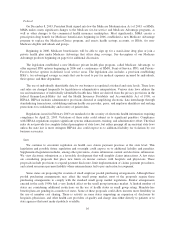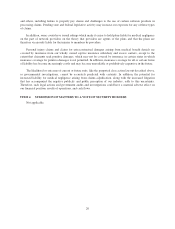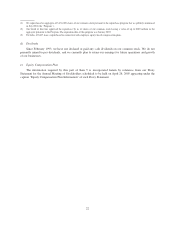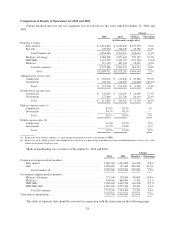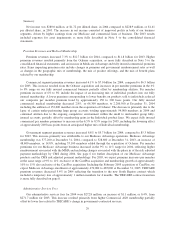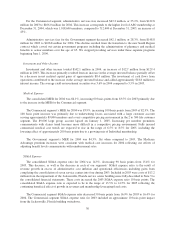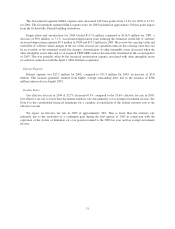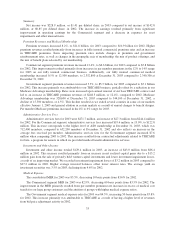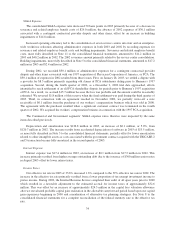Humana 2004 Annual Report Download - page 35
Download and view the complete annual report
Please find page 35 of the 2004 Humana annual report below. You can navigate through the pages in the report by either clicking on the pages listed below, or by using the keyword search tool below to find specific information within the annual report.Our results are impacted by many factors, but most notably are influenced by our ability to establish and
maintain a competitive and efficient cost structure and to accurately and consistently establish competitive
premium, ASO fee, and plan benefit levels that are commensurate with our medical and administrative costs.
Medical costs are subject to a high rate of inflation due to many forces, including new technologies and medical
procedures, increasing capacity and supply of medical services, new prescription drugs and therapies, an aging
population, the tort liability system, and government regulations.
Our strategy to drive Commercial segment profitability focuses on providing solutions for employers to the
rising cost of health care through the use of a variety of innovative and consumer-directed product designs. These
products are supported by electronic informational capabilities, including education, tools, and technologies
provided primarily through the Internet. To that end, we have developed an innovative suite of products styled as
“Smart” products. We believe that these Smart products offer the best solution for many employers to the
problem of quickly rising health care costs for their employees. Membership in our Smart products and other
consumer-directed health plans exceeded 280,000 members at December 31, 2004, more than doubling from a
year ago. We believe that growth in these products, which are offered both on a fully-insured and ASO basis and
may ultimately be competitively priced to produce higher margins, is a key component, among other items, for
further improvement in the results of our Commercial segment. Additionally, we have increased the
diversification of our commercial membership base, not only through our consumer-choice products, but also by
(1) expanding our ASO membership to take advantage of our network discounts in the mid-market group
segment and (2) launching our HumanaOne individual product to address an increasing migration of insureds
from small group. While we expect our Smart products to become a driver of growth in the years ahead as health
care inflation persists, we are enhancing the traditional products which comprise the bulk of our commercial
portfolio today by applying our consumer-choice innovation.
Other important factors which impact our Commercial segment profitability are both the competitive pricing
environment and market conditions. With respect to pricing, there is a tradeoff between sustaining or increasing
underwriting margins versus increasing or decreasing enrollment. We have experienced a decline in our
membership in the 2 to 300 life group size as a result of pricing actions by some competitors who we perceive as
desiring to gain market share in certain markets. With respect to market conditions, we are impacted by
economies of scale on administrative overhead. As a result of a decline in preference for tightly-managed HMO
products, medical costs have become increasingly comparable among the larger competitors. Product design and
consumer involvement have become more important drivers of medical services consumption, and administrative
expense efficiency is becoming a more significant driver of commercial margin sustainability. Consequently, we
continually evaluate our administrative expense structure and realize administrative expense savings through
productivity gains. Additionally, because our Commercial segment shares overhead costs with our Government
segment, an increase or decrease in the size of our Government operations impacts our Commercial segment
profitability.
In our Government segment, after being awarded the South Region contract in 2003, we transitioned our
TRICARE business to one of three newly-created regions under the government’s revised TRICARE program.
On July 1, 2004, our Regions 2 and 5 contract servicing approximately 1.1 million TRICARE members became
part of a new North Region, which was awarded to another contractor. On August 1, 2004, our Regions 3 and 4
contract became part of our new South Region contract. On November 1, 2004, the Region 6 contract, previously
administered by the same contractor, with approximately 1 million members, became part of the South Region
contract. The members added with the Region 6 contract essentially offset the members lost four months earlier
with the Regions 2 and 5 contract. With the transition complete, we look forward to a more stable level of
TRICARE membership in 2005 and the start of the second option year under the South contract on April 1, 2005.
As more fully discussed on page 45, TRICARE revenues consist of an underwriting fee, healthcare services
provided to beneficiaries which, in turn, are reimbursed, and administrative services fees primarily related to
claim processing and customer service.
In our Medicare business, the passage of the Medicare Prescription Drug, Improvement, and Modernization
Act, or MMA, in December 2003 demonstrated the federal government’s commitment to providing health
25



